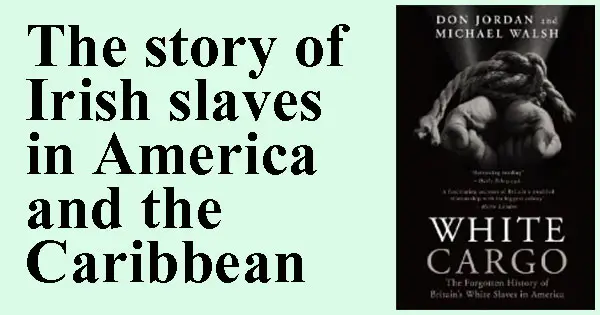Thousands of Irish people were subjected to years of abuse and cruelty after being sold as slaves during the 17th and 18th centuries. That is the claim made by London based historians and authors Don Jordan and Michael Walsh.
The two men have written a book, White Cargo, which says that one of the darkest periods in Irish history may have been swept under the carpet for centuries.
The book details how thousands of Irish men, women and children were shipped across the Atlantic Ocean to the Caribbean and America to work as labourers during the 17th and 18th centuries.

There was a term at the time known as indentured servants. This meant that labourers would work for their employers for free for a fixed length of time in return for being granted their freedom and given some land at the end of their service. Many Irish people travelled to America and the Caribbean under these terms.
Many of them were treated badly and even betrayed at the end of their service when the landowner reneged on the deal.
However, Jordan and Walsh claim that the cruelty and injustice went further than this. They say many of these indentured servants were effectively slaves. They also believe that thousands more Irish people were transported to the Caribbean from the 1600s up to the 1800s, not to work as indentured servants, but to be sold into a lifetime of slavery.
Henry VIII wanted to regain control of Ireland
The atrocity began towards the end of the reign of Queen Elizabeth I. Britain claimed sovereignty over Ireland following the Norman invasion a few centuries earlier. In actual fact, Ireland was still separated into several family clans and mini-kingdoms and was difficult to govern. Many of the Anglo-Norman settlers had inter-married and formed allegiances with the native Irish clans. The British had even raised the concern that the Norman settlers had become ‘more Irish than the Irish’!

Henry VIII decided to address the issue. He declared himself ‘King of Ireland’ and granted several positions of Irish nobility to English settlers. He wanted to control Ireland from afar, and alter their customs and cultures to make them more English. The main stumbling block with this was his Protestant religion, with most of Ireland being Catholic. Henry used force to take control of large areas in Ireland.
His invasion into Ireland was continued by his daughter, Queen Elizabeth I. During this same period, British sailors had begun capturing native Africans and selling them as slaves to New World settlers in the Americas.
Britain needed to get rid of Irish political prisoners
Towards the end of Elizabeth’s reign, Britain finally defeated the Irish rebels at the Battle of Kinsale. This victory left more than 30,000 Irish soldiers as political prisoners. Britain tried to solve the problem of what to do with them by creating a policy of banishment. The Irish soldiers were forced to leave their country, with many moving to Spain and France to join foreign armies.
However, this enforced banishment wasn’t enough. Thousands of rebels remained in Ireland and the British needed to find a way to get rid of them. James I had inherited the crown from Elizabeth, and he ordered the transportation of Irish prisoners to work as labourers. At the time, slavery was not considered barbaric and cruel. Thousands of men were being taken from Africa and sold into slavery in America. It was a profitable business.
The first record of Irish people being sold in this way comes from 1612 when a group of men were sold to settlers in South America. It is highly likely that similar events took place before this though, as records of Irish matters in this period are scarce.
The demand for labour was high in the Americas and the Caribbean, as European settlers began to set up new communities. Regular trips to Africa to purchase people to be sold into slavery were taking place by the 1620s. However, the trips were expensive, and the people had to be purchased.
In 1625, the British made it law that Irish political prisoners should be transported and sold to English settlers in America and the Caribbean. The policy was a profitable one for the British sailors, but there were not enough prisoners to keep up with the demand. To combat this, any minor infringement became punishable by transportation. Rogue gangs also roamed the streets in Ireland searching for potential kidnapping targets that could also be transported. Jordan and Walsh describe the Irish people at this time as “nothing more than human cattle”.
Cromwell finally crushed the Irish resistance
A group of Irish clans rose up to fight the British in 1641. Oliver Cromwell stamped this out with a brutal and violent sweep across the country, fully establishing his rule by 1652. Irish land was taken and given to British settlers. Those Irish that hadn’t been slaughtered were made to work as peasants for their new landlords. Any Irish resistance was dealt with by transportation.

Jordan and Walsh believe that thousands of Irish people were transported over the next hundred years, even for minor crimes.
The journeys were highly dangerous for the Irish captives. Overcrowding and disease were major problems on the ships and life was cheap. The book, White Cargo, describes how on one voyage, more than 1,000 captives were dumped into the Atlantic Ocean to make sure the crew had enough food to complete the journey after the ship had run into difficulty.
The Irish were cheap to buy for the Caribbean settlers. A price of 900lbs of cotton was the standard amount paid. The African slaves were more expensive, averaging around three or four times that amount. This made the lives of Irish slaves less valuable to the landowners, and they suffered terrible cruelties because of this.
Any disobedience or attempt at escape was punished with severe brutality. Slaves would be bound by the hands and lifted before their feet were set alight.
Heavy beatings and thrashings were also commonplace. The Irish labourers in Barbados were known as ‘Redlegs’, because their fair skin would burn more rapidly than those of their dark skinned counterparts.
Women raped to produce more cheap labour
Jordan and Walsh also highlight another horrific act that took place on these new settlements. The settlers would breed with the female workers, to produce more cheap labour. The child would be under the ownership of the settlers, and the mothers would rarely leave their children in such conditions, even after their terms of labour had expired. Another method settlers used to produce cheap labour was to breed the Irish women with the African men. The resulting skin tone of the offspring was more valuable to landowners in the slave markets.

This practice was made illegal in 1681, not because of the horrific acts of rape and dehumanisation, but because the cheap labour being produced was not in the interest of British slave traders.
Back in Ireland, the Jacobite Wars ended in 1691 with William of Orange finally defeating James II’s armies. This again, left thousands of Irish Catholics unwilling to accept the rule of the Protestants. They were given the opportunity to leave the country for France. Around 30,000 Irish people took this opportunity and they became known as the Wild Geese. Most of those that refused were transported to labour camps.
The United Irishmen’s unsuccessful 1798 Rebellion created the opportunity for the British to ship thousands more Irishmen and women overseas, with Australia now also a common destination.
The sequence finally ended in 1839, when Britain finally decided to end their involvement in the slave trade.
There is little documentary evidence to support many of the claims made in White Cargo. It is possible that this because the events were never recorded or the records have been deliberately lost over the years to protect the British reputation.
Whether the Irish labourers were transported and sold as slaves is unproven. What is certain is the suffering and brutality they endured at the hands of the European settlers.
More Irish history articles
The Celts were not first people to live in Ireland – who was here before?
The Neolithics – first people to leave their mark on Ireland
https://ireland-calling.com/irish-potato-famine/
Easter Rising 1916 – six days that changed course of history